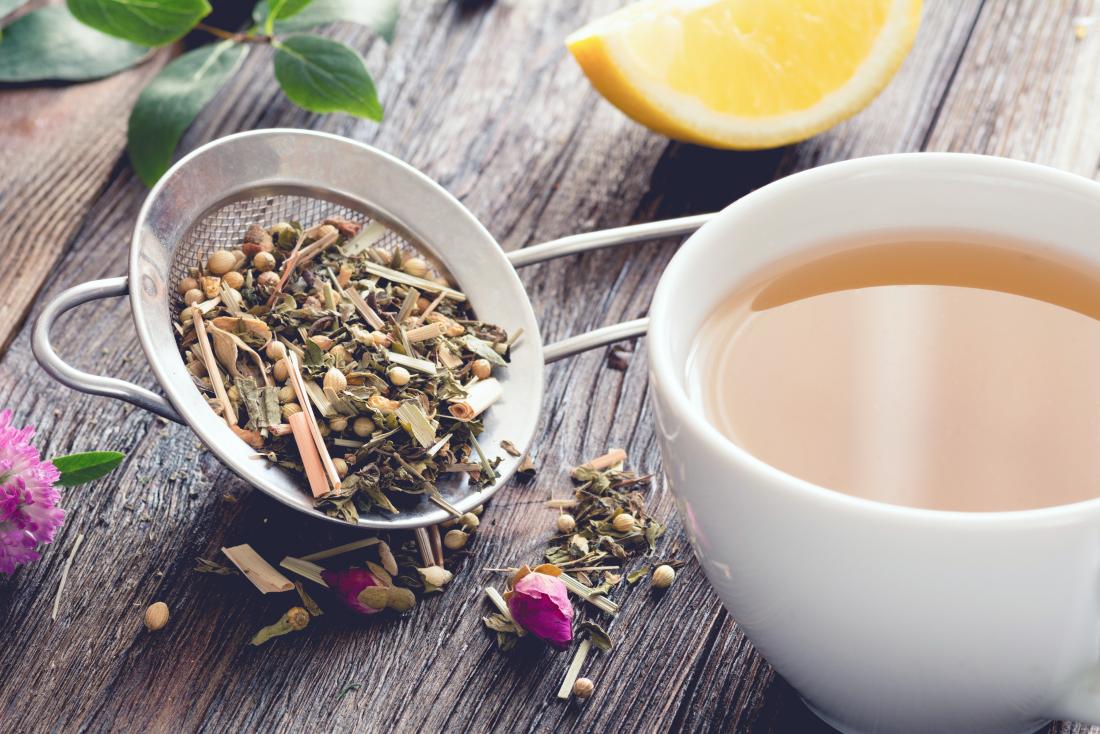Due to its sweet flavor, licorice is also popular as a sweetener in candies, and manufacturers sometimes use it to mask the flavor of medications. Some licorice candy does not contain any part of the licorice plant but uses anise oil as a flavoring instead because it tastes and smells similar to licorice.
Licorice is available in many forms, including herbal teas, candies, capsules of dried herb, and liquid extract.
Benefits of licorice
There are more than 300 different compounds in licorice, some of which have antiviral and antimicrobial properties.
Some clinical studies investigating the potential benefits of licorice have had promising results, particularly in the following areas:
Skin inflammation and infection

Licorice root may help treat eczema.
Eczema is the term for a group of skin conditions that, according to the National Eczema Association, affect over 30 million people in the United States.
Eczema can cause itching, redness, scaling, and inflammation.
Glycyrrhiza glabra extract, or licorice root extract, may be effective against bacteria that can infect the skin, according to a study in the Iranian Journal of Pharmaceutical Research.
The study showed antimicrobial activity against Staphylococcus aureus, which can cause skin infections, such as impetigo, cellulitis, and folliculitis. In this study, the researchers used extracts from the leaves and roots of the plant.
Stomach discomfort and ulcers
A double-blind study found that an extract containing glabridin and glabrene, which are flavonoids present in licorice root, was effective in relieving stomach discomfort. The extract reduced nausea, stomach pain, and heartburn.
Infection with bacteria called Helicobacter pylori can cause peptic ulcers in some people. Research suggests that a licorice extract may help kill H. Pylori bacteria. A clinical trial of 120 people found that the addition of licorice extract to the standard treatment significantly improved H. Pylori eradication.
Hepatitis C
Glycyrrhizin may help treat hepatitis C, a virus that infects the liver. Without treatment, hepatitis C can cause inflammation and long-term liver damage. Researchers have reported that glycyrrhizin demonstrates antimicrobial activity against hepatitis C in cell samples and may hold promise as a future treatment for this virus.
Doctors in Japan use an injectable form of glycyrrhizin to treat people who have chronic hepatitis C that does not respond to other treatments. The results of laboratory studies in Japan suggest that it may be helpful for this.
Tooth decay
Some research suggests that licorice may help kill bacteria in the mouth that cause tooth decay.
However, although licorice has demonstrated antibacterial activity in the laboratory setting, human studies have not yet proven that it has any cavity-fighting power. Its ability to inhibit the growth of oral bacteria means that it does have potential as a future cavity treatment though.
Sore throat
Many people think of licorice as a sore throat remedy. A small study recruited people who were having a breathing tube inserted into their windpipe before surgery. Following its removal, the breathing tube can cause a postoperative sore throat, known as POST.
The researchers showed that gargling a licorice solution for 1–15 minutes before surgery was as effective as a ketamine gargle in reducing the incidence and severity of POST.
Another similar study found that solutions with a higher concentration of licorice were more effective than less concentrated solutions in improving POST.
Dosage

Taking an unsuitable dosage of licorice supplements can cause side effects.
The dosage of licorice depends on the condition that needs treating. However, people should never consume excessive amounts of licorice in food or supplement form.
People who have high blood pressure or low potassium levels should avoid licorice candy and glycyrrhizin supplements altogether.
Licorice supplements are available without the glycyrrhizin, in the form of deglycyrrhizinated licorice (DGL).
Consuming large quantities of glycyrrhizin can result in side effects, including:
Lower potassium levels
Consuming too much licorice can cause potassium levels to drop. According to the U.S. Food and Drug Administration (FDA), this can lead to:
- abnormal heart rhythms
- high blood pressure
- swelling
- lethargy
- congestive heart failure
Overdose
The World Health Organization (WHO) state that a limit of 100 milligrams per day of glycyrrhizic acid would be “unlikely to cause adverse effects in the majority of adults.”
However, many candies and supplements do not list the exact amount of glycyrrhizic acid in the product. This lack of detailed information makes overdose a possibility, especially for children who eat lots of licorice candy over extended periods.
In one case, a 10-year-old boy who ate large amounts of black licorice for 4 months developed high blood pressure and a syndrome that causes seizures.
Another case involved a woman who drank eight cups of herbal tea containing licorice daily. She went to the hospital with high blood pressure and low potassium, which both resolved when she stopped drinking the tea.
Pregnancy issues
Pregnant women should not consume large quantities of licorice or take licorice root as a supplement.
One study found that the glycyrrhiza in licorice could harm the developing brain of the fetus, leading to cognitive problems later in life. An older study found that heavy licorice consumption during pregnancy could lead to preterm birth.
DGL may be a safer option for those who wish to take licorice for more extended periods. Pregnant women should not take DGL or any other supplement without first discussing it with a doctor.
Potential drug interactions
Medications that interact with licorice include:
- drugs that lower potassium
- blood pressure medications
- diuretics, also called water pills
- heart rhythm medications
- blood thinners, such as warfarin (Coumadin)
- estrogen, hormone therapy, and birth control pills
- corticosteroids
Some people may be able to take DGL supplements to avoid these interactions, but they should ask a doctor first.
How to use licorice root

Drinking licorice tea is an easy way to include licorice in the diet.
Licorice is available in the form of chewable tablets, a liquid extract, capsules, a powder, and a loose herb.
People can use licorice in a variety of ways for medicinal purposes, such as:
- Mixing the herb with a skin-friendly gel, such as aloe vera gel, to help eczema.
- Steeping loose herbs in hot water to make tea for a sore throat or purchasing a prepared herbal tea that has licorice as a primary ingredient.
- Adding liquid licorice extract to a beverage or taking it under the tongue as a treatment for ulcers or stomach problems.
- Taking licorice capsules and chewable tablets according to the instructions on the packaging or the advice of a healthcare professional.
People should not consume licorice candies, teas, or supplements for extended periods without speaking to a doctor first. It is best to use DGL supplements rather than licorice if high blood pressure or low potassium levels are a concern.
Takeaway
Licorice is an ancient remedy that has demonstrated some potential health benefits in clinical studies and laboratory tests.
While it may be beneficial for certain health conditions, people should always check with a healthcare professional that it will not interfere with any medications or cause adverse side effects.
Let’s block ads! (Why?)





